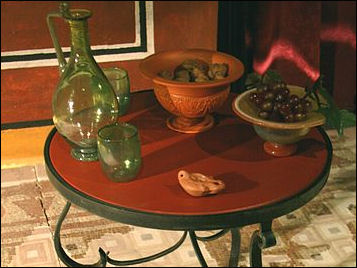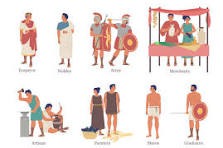Roman Diets and Social Classes
Roman Diets and Social Classes. Ancient Romans, known for their love of food, drink, gladiatorial combat, thermal baths, and exclusive banquets, had a unique dining culture. The rich and the poor had vastly different dining experiences, but public spaces were a great leveler. These spaces were open to all, where Romans, citizens or not, could enjoy their meals, whether on the go, with family, or even lying down at a wealthy benefactor’s villa. The evidence of this social dining culture is clear in the mosaics and ruins of Herculaneum and Pompeii.

The influence of social class on the Roman diet was profound. Elites had access to and indulged in exotic food imports across the empire, stretching from the Mediterranean Sea to Great Britain, Western and
Central Europe, North Africa, and Western Asia. In contrast, poorer Romans and slaves became reliant on seasonal and local nutrition. This stark contrast in diet was a reflection of the disparities in Roman society, with life in the city and rural countryside, especially for the slaves, being vastly different.
The Roman diet was not static. The Roman Empire brought many new foods to Europe. However, the
Romans didn’t eat chocolate or tomatoes. These items are new world foods from the Age of Discovery.
Ancient Romans liked dried nuts and fruits. These items were helpful in travel and long-term storage
during the wintertime. Some parts of the Roman Empire were far colder than the Mediterranean and
Tuscany. Let’s dive further into the Roman world and see what food and drink items were available by
class.
Roman Diets and Social Classes. Patrician Diet
Patricians are the aristocratic, wealthy, and/or ruling class of ancient Rome. This elite class ate local and
exotic food and drink imports from around the empire. For example, rich Romans ate meat (beef,
mutton, poultry, fish, and oysters). They ate three meals a day. Breakfast was usually light with bread,
wine, cheese, fruit, eggs, and honey. Lunch time could include eggs, fruit, and greens. Dinner was the
day’s big meal, usually a banquet or luxury mealtime. The meal began with eggs, and the main course
came with meat or fish dishes with vegetables.

High society Romans ate nuts, oils, vinegar, and, of course, garlic. Men and women would lie on couches to enjoy their meal. Fresh fruit (apples and grapes), dried fruit, figs, and nuts (walnuts, pistachios, hazelnuts, pine nuts, chestnuts, and almonds) were served as desserts. Wine is the drink of choice because water was seen with suspicion as a source of water-borne illnesses. This fear of water-borne diseases was a significant factor in the dietary habits of the elite class. Meals were made by a chef in the wealthy person’s home or villa.
Roman Diets and Social Classes. Plebeian Diet
Plebeians are the ordinary people, who could be tradespeople or the working poor. Their diets were
significantly different than those of the elite class Romans. A significant difference deals with meat
consumption. For example, the poorer classes didn’t usually eat beef. Their food is seen as more of a
plant-based grain and protein diet, with very little meat. The poor typically ate a porridge dish or ‘puls.’
It is made by mixing wheat and water. Vegetables and fruits could be additions to offer some variety.
Poor Romans sometimes ate nuts (almonds, pistachios, and chestnuts) and seeds (poppy and sesame), if
they could afford it. They also ate bread, cheese, and olives.

The government gave the poor class a ‘grain dole’ or cheap grain to gain political favour. This was a significant part of ancient Rome’s social and political structure. Poor Romans drank some form of wine
right along with the wealthy. It was either much cheaper wine or watered down. Many plebeian households hunted daily for food and shelter. Even tradespeople who occasionally fell into poverty fell
into suit. It is believable they didn’t cook a lot. So, they ate street food or raw food at a local pub. Eating three meals daily would have been an unaffordable luxury, highlighting ancient Rome’s stark social class distinctions.
Modern Diets
Industrialised nations like the United Kingdom provide a wide array of diet options, some of which are
reminiscent of the choices available to the wealthy ancient Romans, albeit with some differences in
preparation and processing. The British enjoy locally made wines and drink import vintages from around
the globe. A diverse range of meats and produce is grown locally and brought to the port. The major
differences in modern British diets include superior water quality and waste disposal systems. While
more processed foods have become a part of the British diet, there is a growing trend towards
consuming raw or minimally processed foods. The variety of modern British diets, including paleo,
vegan, and vegetarian options, is sure to intrigue any food enthusiast.
Ancient Roman diets were dependent upon one’s social standing and limited what was available. A poor
Roman’s diet was almost entirely vegetarian, while the elite class was omnivorous. The working classes
spent much of their day trying to provide food and shelter for themselves and their families. They didn’t
cook often and ate on the go. The Roman diet was creatable due to the vastness of the Roman Empire,
with wines and foods imported into Rome from all over the empire, even though many goods were
produced locally.

Modern British people can recreate a wealthy Roman’s diet by shopping online with retailers like Walnut Tree, ASDA Foods, Tesco, Amazon, and Sainsbury’s. Local supermarkets and farmers’ markets are also great places to find fresh ingredients. During World War II, Victory Gardens were popular in Great Britain. It may be time to start a backyard garden again.
And next time you’re in Rome don’t forget to sample their world famous ice creams… it’s class free and delicious
About Walnut Tree- the finest edible gifts
Great Taste Awards
With Great Taste Awards for nougat, dried fruit, marron glacé, glacé fruit and pate de fruit. You’ll always be purchasing quality products from Walnut Tree.
Who we supply
Supplied under own brand or white label to prestigious stores, palaces, castles, stately homes, garden centres, delicatessens, farm shops, hamper companies, department stores and gift shops.
Why buy from us?
You’re buying directly from the source and will get excellent value for money. If you’re not happy with your purchase, we’ll refund or replace it. The website is open 24/7, orders despatched within 48 hours.
Our charitable contributions
Walnut Tree supports Future Dreams Breast Cancer Charity with dried fruit for their care packages. www.futuredreams.org.uk
Local areas to our factory
AL1 | AL2 | AL3 | AL9 | AL10 | EN6 | EN5 | EN4 | NW4 | NW7 | NW9 | WD6 | WD7 | WD17 | | WD19 | WD23 | WD24 | WD25 | Aldenham | Barnet | Borehamwood | Brent X | Bushey | Colney Street | Edgware | Elstree | Finchley | Frogmore | Hatfield | Hendon | Hertfordshire | Hertsmere | Leavesden | London Colney | Mill Hill | New Barnet | North London | Potters Bar | Radlett | Shenley | South Mimms | Stanmore | St. Albans | Southgate | Watford | Welham Green | Whetstone | Woodside Park

